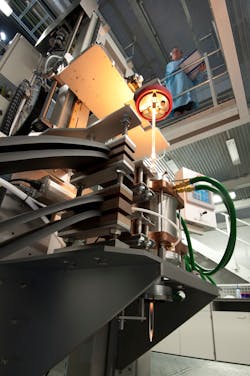High-power fiber lasers are poised to boost industrial manufacturing
Lasers are a key component in industrial manufacturing applications. Specifically, carbon dioxide (CO2) lasers are best suited for cutting and boring; neodymium (Nd) lasers are used for boring and welding of materials; and neodymium yttrium-aluminum-garnet (Nd:YAG) lasers are used for high-power engraving, welding, and boring. These three types of lasers have long been industry standards.
But now, there’s a new laser in town.
“High-power fiber lasers are now the laser of choice in manufacturing. They’re the latest entry into the manufacturing arena,” says Professor Michalis N. Zervas, Ph.D., the Royal Academy of Engineering Chair in Advanced Fibre Laser Technology for Future Manufacturing at the University of Southampton (UK). He’s also head of the high-power fiber laser group at Southampton’s Zepler Institute.
While fiber lasers are a 20-year-old technology, their robust and efficient nature makes them attractive options for manufacturing applications, explains Zervas. “High-power fiber lasers offer efficiencies on the order of 30 to 50% or even more, as opposed to a few percent to 10% of the competing technology including CO2, Nd, and Nd:YAG,” he says.
Bringing high-power fiber lasers more prominently into the manufacturing realm is among the top initiatives for the Future Photonics Hub at the University of Southampton. The main scope of the Hub is to demonstrate the manufacturability of innovative products and systems; companies want to see how these products are applicable to their customers and also manufacturable. The Hub takes ideas from the lab with the goal of progressing them to be suitable for industry use, according to Zervas.
This is where his team’s work to advance high-power fiber lasers in manufacturing began. The Hub is developing all the fiber technology to accompany a standard high-power laser, to make it practical, manufacturable, and repeatable.In control
With industrial manufacturing, precision is crucial. The creation of aircraft, automobiles, and ships rely on it, as do many other applications—from the production of furniture and clothing to computers and electrical equipment.
Fiber optics technology in lasers, which enables multiple beams, provides that precision. “A unique property of fiber optics is their ability to be controlled,” Zervas says. “Because they are fiber throughout, you have this ability to control the shape of the beam coming out. You can control the shape and modes of operation in the fiber.”
This trait is not always possible with other technologies, including lasers. “The fiber always guides the light,” Zervas says, noting laser beam light is not “free-space propagation,” so light is in the fiber. This has proven to be extremely efficient and important in research and development, and key in manufacturing.
Within manufacturing, fiber lasers have traditionally provided power for the overall system to perform various material processing functions, such as melting components and cutting through them. Researchers are now realizing what fiber lasers can do better than others, including beam shaping. When the power exits the fiber laser, it can be in a shape optimized and tailored to the process.
“Very effectively, you have not just one laser firing into the workpiece, you can have several fiber lasers combined together coherently,” Zervas says. “And then that coherent combination, which is a totally different way of building lasers, really gives you an almost unlimited power scaling. It also provides beam reconfigurability because you have multiple lasers combined together.”
Zervas compares fiber lasers to the various degrees of freedom and control available on roadways—current laser technology would be a single-lane highway, in which there is little control; vehicles must follow the same lane and flow. Fiber technology can be likened to a multiple-lane highway, which is “more traffic accommodating” and can be controlled.
“With these new lasers we are working on, the controllability of fiber technology opens up a new range of ways of building lasers. And it's something absolutely needed by industry in the digital manufacturing era,” he says. Being able to “change the shape will also control the power delivery and the timing in the process.”
Functionality and applications
Beam shaping, polarization, and wavelengths rely, in part, on the laser’s power. Enhancing that power’s strength and functionality makes it more usable. The high-power fiber laser technology currently being investigated and developed by the Hub team provides 10 kW of power per fiber, which is “quite a lot,” according to Zervas. This could ultimately aid the delivery of that power over longer distances—potentially hundreds of meters to a kilometer.
“This will have a huge impact on how the factory workplace will change in the future,” Zervas says. “Future factories, especially with robotics, and the digital and additive manufacturing principles, will all be reconfigurable.”
This means light will not be used and distributed in the same way electricity is throughout a manufacturing facility. Rather than plugging in various appliances in different places in the building, the fiber technology can expand that energy over longer distances.
““By being able to deliver power photons remotely, we will have the ability to easily reconfigure the production lines or re-arrange the workplace, depending on the different tasks you're trying to do,” he says. “That’s a very, very important capability as we move into the digital manufacturing future.”
Additive manufacturing is already pushing the overall manufacturing field into the future. Also known as 3D printing, additive manufacturing allows the creation of lighter, stronger parts, enabled by a shift from analog to digital in manufacturing processes. Rather than beginning with a block of metal (or other such material) that must be cut, shaped, and welded into a particular form, the additive manufacturing process uses lasers to create components layer by layer to make customized shapes.
Controllability, freedom, and higher power over longer distances are key to the 3D printing process. Fiber is the best, most efficient way to deliver beam power over longer distances, and provides beam-shaping control and liberty, making it ideal for additive manufacturing. “It changes the way things are done in terms of strength, in terms of shape, in terms of weight,” says Zervas.
The advanced efficiency high-power fiber lasers provide could ultimately benefit the manufacturing of things such as aircraft and automobiles—lighter, stronger components mean more energy efficiency. “Lighter structures consume less energy,” Zervas says, noting fiber laser technology’s implications with green manufacturing. “With a fiber laser’s multi-spot beam at kilowatt levels, we’ve shown you can do welding using half the power, 30% faster, just by being able to change the shape of the light.”
Zervas believes this new type of high-power fiber laser “will open up a huge number of opportunities and possibilities that cannot be implemented with other laser technologies.” After bringing it to industry, the next step is to scale up.

Justine Murphy | Multimedia Director, Digital Infrastructure
Justine Murphy is the multimedia director for Endeavor Business Media's Digital Infrastructure Group. She is a multiple award-winning writer and editor with more 20 years of experience in newspaper publishing as well as public relations, marketing, and communications. For nearly 10 years, she has covered all facets of the optics and photonics industry as an editor, writer, web news anchor, and podcast host for an internationally reaching magazine publishing company. Her work has earned accolades from the New England Press Association as well as the SIIA/Jesse H. Neal Awards. She received a B.A. from the Massachusetts College of Liberal Arts.

